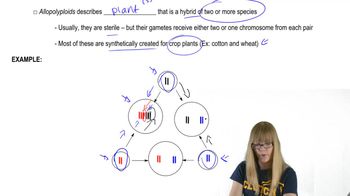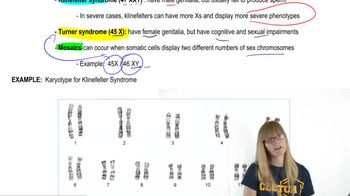Table of contents
- 1. Introduction to Genetics51m
- 2. Mendel's Laws of Inheritance3h 37m
- 3. Extensions to Mendelian Inheritance2h 41m
- 4. Genetic Mapping and Linkage2h 28m
- 5. Genetics of Bacteria and Viruses1h 21m
- 6. Chromosomal Variation1h 48m
- 7. DNA and Chromosome Structure56m
- 8. DNA Replication1h 10m
- 9. Mitosis and Meiosis1h 34m
- 10. Transcription1h 0m
- 11. Translation58m
- 12. Gene Regulation in Prokaryotes1h 19m
- 13. Gene Regulation in Eukaryotes44m
- 14. Genetic Control of Development44m
- 15. Genomes and Genomics1h 50m
- 16. Transposable Elements47m
- 17. Mutation, Repair, and Recombination1h 6m
- 18. Molecular Genetic Tools19m
- 19. Cancer Genetics29m
- 20. Quantitative Genetics1h 26m
- 21. Population Genetics50m
- 22. Evolutionary Genetics29m
6. Chromosomal Variation
Chromosomal Mutations: Aneuploidy
Problem 9
Textbook Question
Describe how nondisjunction in human female gametes can give rise to Klinefelter and Turner syndrome offspring following fertilization by a normal male gamete.
 Verified step by step guidance
Verified step by step guidance1
Understand the concept of nondisjunction: Nondisjunction is the failure of homologous chromosomes or sister chromatids to separate properly during meiosis. This can occur during meiosis I (failure of homologous chromosomes to separate) or meiosis II (failure of sister chromatids to separate).
Explain how nondisjunction in female gametes can lead to Klinefelter syndrome: If nondisjunction occurs in the X chromosomes during oogenesis, the resulting egg may contain two X chromosomes (XX). When this egg is fertilized by a normal male sperm carrying a Y chromosome, the resulting zygote will have the karyotype 47,XXY, which is characteristic of Klinefelter syndrome.
Explain how nondisjunction in female gametes can lead to Turner syndrome: If nondisjunction occurs in the X chromosomes during oogenesis, the resulting egg may lack an X chromosome (denoted as 0, or nullisomic for the X chromosome). When this egg is fertilized by a normal male sperm carrying an X chromosome, the resulting zygote will have the karyotype 45,X, which is characteristic of Turner syndrome.
Highlight the role of the normal male gamete: In both cases, the male gamete contributes either an X or a Y chromosome, which combines with the abnormal female gamete to determine the final karyotype of the offspring.
Summarize the outcomes: Nondisjunction in female gametes can result in aneuploidy (abnormal chromosome number) in the offspring. Fertilization of an XX egg with a Y sperm leads to Klinefelter syndrome (47,XXY), while fertilization of a 0 egg with an X sperm leads to Turner syndrome (45,X).
 Verified video answer for a similar problem:
Verified video answer for a similar problem:This video solution was recommended by our tutors as helpful for the problem above
Video duration:
2mPlay a video:
Was this helpful?
Key Concepts
Here are the essential concepts you must grasp in order to answer the question correctly.
Nondisjunction
Nondisjunction is the failure of homologous chromosomes or sister chromatids to separate properly during cell division, specifically meiosis. This error can lead to gametes with an abnormal number of chromosomes. In females, if nondisjunction occurs during the formation of eggs, it can result in eggs that have either an extra chromosome or a missing chromosome, which can lead to genetic disorders when fertilized.
Recommended video:
Guided course

Allopolyploidy
Klinefelter Syndrome
Klinefelter syndrome is a genetic condition that occurs in males who have an extra X chromosome, resulting in a 47,XXY karyotype. This condition can arise when a normal male gamete fertilizes a female gamete that has undergone nondisjunction, leading to the presence of an additional X chromosome. Individuals with Klinefelter syndrome may experience symptoms such as reduced testosterone levels, infertility, and physical traits like taller stature.
Recommended video:
Guided course

Human Sex Chromosomes
Turner Syndrome
Turner syndrome is a chromosomal disorder that affects females, characterized by the complete or partial absence of one X chromosome, resulting in a 45,X karyotype. This condition can occur when a normal male gamete fertilizes a female gamete that has lost an X chromosome due to nondisjunction. Turner syndrome can lead to various developmental issues, including short stature, ovarian dysfunction, and heart defects.
Recommended video:
Guided course

Human Sex Chromosomes
Related Videos
Related Practice
Textbook Question
What evidence indicates that humans with aneuploid karyotypes occur at conception but are usually inviable?
462
views


